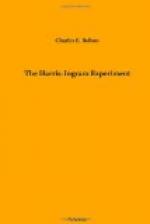Mr. Bessemer’s own story of his most important invention was very interesting. Practical iron men had said that it was an impossible feat to convert molten pig iron in a few minutes into fluid malleable iron, and then into available steel, and all this without additional fuel. But the genius and perseverance of Mr. Bessemer, aided by his practical knowledge of chemistry and mechanics, did it. It had long been known that, if a horseshoe nail were tied to a cord and the point heated to whiteness, the iron nail could be made to burn in common air by being whirled in a circle. The ring of sparks proved a combustion. Mr. Bessemer was the first however to show that if air was forced, not upon the surface, but into and amongst the particles of molten iron, the same sort of combustion took place.
Pig iron, which is highly carbonized iron from the blast furnace, was laboriously converted into malleable iron by the old process of the puddling furnace. Bessemer conceived the process of forcing air among the particles of molten iron, and by a single operation, combining the use of air in the double purpose of increasing temperature, and removing the carbon. The carbon of the iron has a greater affinity for the oxygen of the air than for the iron. When all the carbon is removed, then exactly enough carbon is added by introducing molten spiegeleisen to produce steel of any desired temper with the utmost certainty.
With the ordinary kinds of pig iron early in use, Bessemer’s process was powerless. The old puddling process was more capable of removing phosphorus and sulphur. But with pig iron produced from the red hematite ores, practically free from phosphorus, Bessemer’s process was a surprising success.
At once exploration began to open vast fields of hematite ores in the counties of Cumberland and Lancashire of England, in Spain, in the Lake Superior regions of North America, and in other countries. Bessemer wisely made his royalty very low, five dollars per ton; capital rapidly flowed into this new industry, and Bessemer won a fortune. Mushroom towns and cities sprung up everywhere and fortunes were made by many.
Mr. Bessemer himself vividly described his process in action: “When the molten pig iron is poured into mortar-like converters, supported on trunions like a cannon, the process is brought into full activity. The blast is admitted through holes in the bottom, when small powerful jets of air spring upward through the boiling fluid mass, and the whole apparatus trembles violently. Suddenly a volcano-like eruption of flames and red-hot cinders or sparks occurs. The roaring flames, rushing from the mouth of the converter, changes its violet color to orange and finally to pure white. The large sparks change to hissing points, which gradually become specks of soft, bluish light as the state of malleable iron is approached.”
This very brilliant process, which includes the introduction and mixture of the spiegeleisen, may occupy fifteen minutes, when the moulds are filled, and the steel ingots can be hammered or rolled the same as blooms from a puddling furnace.




